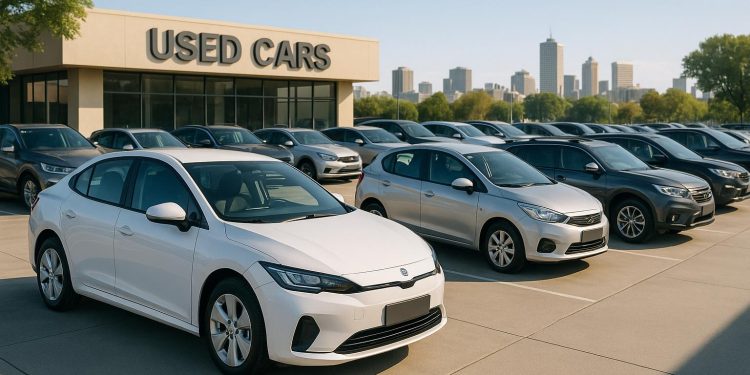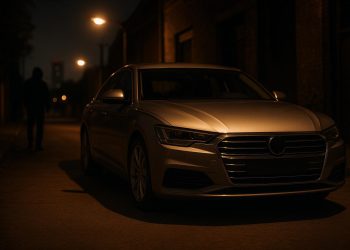Used car prices in South Africa are shifting in 2025 due to rising new car costs, economic pressures, and the growing interest in electric vehicles (EVs). Here’s what you need to know:
- Economic Factors: Inflation, high interest rates (above 11%), and a weakened rand are pushing more buyers toward used cars.
- Supply Chain Issues: New car shortages caused by global disruptions are driving up demand and prices for used vehicles.
- EV Influence: Early EV models, like the Nissan Leaf, are entering the used market, but adoption is slowed by limited infrastructure and power outages.
- Segment Trends: Entry-level hatchbacks and compact sedans remain affordable, while SUVs, pickups, and luxury cars vary widely in price based on mileage, condition, and features.
For buyers, timing and thorough research are key to securing a good deal. Sellers should focus on competitive pricing and clear presentation to attract buyers in this dynamic market.
South Africa’s used car market shifts | KayaBiz | KayaFM

Market Overview: Used Car Pricing Trends in 2025
The used car market in South Africa during 2025 reveals a mix of steady and upward pricing trends across different vehicle categories. While prices in some segments have stabilized following recent fluctuations, others continue to climb. This shift is largely driven by an increase in first-time buyers and current car owners gravitating toward more affordable options in response to changing economic conditions. Let’s take a closer look at the current and projected price ranges for various vehicle segments.
Current and Projected Price Ranges
Entry-level hatchbacks remain the go-to choice for many buyers, thanks to their affordability, dependable performance, and relatively low maintenance costs. Compact sedans, sitting in the mid-range of the pricing spectrum, have gained recognition for their ability to retain value over time, making them a solid investment.
SUVs and crossovers show a broad spectrum of prices, influenced by factors like age, mileage, and available features. These vehicles range from budget-friendly options to high-end models that hold their resale value well. On the other hand, the luxury vehicle segment paints a more varied picture. Depreciation rates for luxury cars differ significantly depending on the brand and model, with more buyers leaning toward economical alternatives in the current market.
Pickup trucks remain a strong contender in the market, especially double-cab models. Their versatility and consistent demand make them a popular choice among buyers.
Vehicle Segment Price Comparison
Several factors shape the pricing trends across these segments. Vehicle age and mileage play crucial roles in determining depreciation. Cars with lower mileage and newer models – particularly in the SUV and luxury categories – tend to command higher prices. In contrast, older vehicles often maintain steady values, especially in budget-friendly segments where mileage is less of a concern.
Regional differences also influence prices. Urban hubs like Johannesburg and Cape Town generally see higher price points compared to rural areas. This is largely due to stronger local demand and the presence of more premium dealerships and certified pre-owned programs in these cities.
Factors Affecting Used Car Prices
South Africa’s used car market in 2025 is being shaped by a variety of factors. These influences help explain why some vehicles hold higher value while others remain more affordable.
Economic Factors and Market Conditions
Economic conditions are playing a significant role in the pricing of used cars. With inflation driving up new car prices by an average of 13% year-over-year in 2025, more buyers are turning to used vehicles as a cost-effective alternative. This shift is evident in financing trends, where two-thirds of financed vehicle purchases in Q2 2025 were for used cars.
Interest rates are another key factor. Car loan rates remain above 11% in 2025, reducing the affordability of vehicles and pushing buyers toward lower-priced options. At the same time, the weakening rand has made imported vehicles and parts more expensive, indirectly affecting used car prices.
Supply chain issues continue to ripple through the market. Semiconductor shortages, global shipping delays, and labor challenges have constrained new car production, creating scarcity that benefits used car sellers. Geopolitical tensions add another layer of complexity. For instance, U.S. tariffs of 30%, introduced in April 2025, have slashed South African automotive exports to the U.S. by as much as 85%. This has led to significant job losses – Ford alone cut over 470 jobs in August 2025, and more than 4,000 jobs were lost across 12 companies over the past two years. These economic setbacks have reduced local purchasing power, further shaping market dynamics.
Electric Vehicle Impact on Pricing
While still small, South Africa’s electric vehicle (EV) market is starting to influence the used car segment. By mid-2025, EVs made up just under 2% of new car sales. Early models like the Nissan Leaf and BMW i3 are now available on used car platforms for under R300,000.
However, challenges persist. Power outages and limited charging infrastructure make EV adoption difficult. Additionally, about 90% of the rare earth minerals used in EV production are sourced from China, creating supply chain risks that could impact pricing. Government policies regarding EVs remain uncertain, leaving questions about future incentives or regulations that could affect market preferences.
Price Driver Pros and Cons
The factors influencing used car prices come with both benefits and drawbacks:
| Factor | Advantages | Disadvantages |
|---|---|---|
| Supply Chain Disruptions | Boosted resale values for used cars | Scarcity of new vehicles; higher maintenance costs due to parts shortages |
| Economic Pressures | Increased demand for affordable used cars | Limited purchasing power; high financing costs (above 11%) |
| EV Market Growth | Affordable entry-level EVs under R300,000; more diverse options | Infrastructure challenges; uncertain resale value for early EVs |
| Manufacturing Job Losses | – | Lower purchasing power; reduced consumer confidence |
These dynamics explain why over 85% of South African car buyers start their search online, looking for deals in a market that’s becoming increasingly complex. Many consumers are opting for reliable used cars and exploring alternative financing options, such as subscription-based models.
At the same time, budget-friendly new car brands like Chery, Haval, and Mahindra are gaining traction. These brands offer competitive features at attractive prices, creating additional pressure on used car prices. Buyers are now weighing the benefits of slightly used premium vehicles against the appeal of affordable, feature-packed new models.
sbb-itb-09752ea
2025 Price Forecasts for Popular Used Car Models
Using the economic and market trends discussed earlier, let’s dive into the projected 2025 pricing for some of the most sought-after used car models. While exact numbers are hard to pin down, current patterns suggest that prices will depend heavily on factors like mileage, condition, trim level, and regional market differences.
Price Ranges for Top Models
Each vehicle segment shows its own pricing trends, reflecting the broader market dynamics at play.
Pickup trucks, such as the Toyota Hilux, are expected to maintain premium prices for low-mileage, double-cab versions. On the other hand, models with higher mileage will offer more affordable entry points. Compact cars like the Volkswagen Polo and Hyundai i20 are likely to hold their value well, especially if they’re in excellent condition and have low mileage. Mid-sized pickups, including the Ford Ranger, and practical work vehicles like the Nissan NP200, will see price differences based on trim level and usage history.
In the luxury car market, models like the BMW 3 Series and Mercedes-Benz C-Class will be priced according to their maintenance records and overall condition. Certified pre-owned options in this category are likely to attract considerable interest from buyers looking for quality assurance.
Model Price Comparison Table
Here’s a general look at expected price ranges for some popular models in 2025. These estimates are subject to change based on specific factors like mileage, vehicle history, and local demand.
| Model | Year Range | Mileage | Price Expectations |
|---|---|---|---|
| Toyota Hilux Double Cab | 2020-2024 | Low | Premium pricing |
| VW Polo 1.0 TSI | 2020-2024 | Low | Strong value retention |
| Ford Ranger Wildtrak | 2020-2024 | Varied | Higher trim premiums |
| Hyundai i20 | 2020-2024 | Varied | Competitive pricing |
| Nissan NP200 | 2020-2024 | High | Budget-friendly |
| BMW 3 Series | 2018-2022 | Varied | Condition-dependent |
| Toyota Corolla | 2020-2024 | Low | Consistent resale values |
| Isuzu KB | 2020-2024 | Varied | Stable pricing |
Electric and hybrid vehicles, like the Nissan Leaf and Toyota Prius, are expected to follow a different pricing trend, with values heavily influenced by the performance and condition of their battery systems.
Commercial vehicles are also likely to remain a strong choice for buyers due to consistent demand from businesses. Regional factors will play a role too – coastal areas might see slightly higher prices due to environmental considerations, while inland markets could offer more competitive deals. Urban hubs like Gauteng are expected to have abundant inventory and dynamic pricing, making them key areas for used car buyers to explore.
Buying and Selling Strategies for 2025
Navigating South Africa’s 2025 used car market requires a thoughtful approach, whether you’re in the market to buy or sell. Understanding the market’s nuances can save you money, time, and stress, making your transaction as smooth as possible.
Here are some practical strategies tailored for both buyers and sellers in this changing landscape.
Tips for Buyers
Do your homework first.
Before committing, dive into the vehicle’s history. Check for any past accidents, flood damage, or unresolved financing. Verify ownership records and service history. Skipping this step could lead to unpleasant surprises down the road.
Pick the right moment to buy.
Timing can make or break a deal. Sellers, including dealerships, often offer discounts when clearing inventory. Stay tuned to market trends rather than relying on outdated seasonal buying advice.
Look beyond the sticker price.
A cheap upfront price can sometimes mean higher long-term costs. Research common problems, repair expenses, and parts availability for the models you’re considering to avoid unexpected maintenance bills.
Negotiate with data, not feelings.
Come prepared with comparable listings and recent sale prices for similar models. Keep your budget private and don’t hesitate to walk away if the deal doesn’t meet your expectations.
Consider certified pre-owned options.
Certified vehicles often come with thorough inspections and extended warranties. While they might cost a bit more, they can provide added peace of mind.
Inspect the car thoroughly.
Always check the vehicle in daylight, and bring along a qualified mechanic if needed. Look for rust, test the electronics, and listen carefully for any unusual engine sounds.
Lastly, stick to trusted local platforms for your transactions to ensure better buyer protection and a smoother process.
Now, let’s shift gears to selling strategies.
Tips for Sellers
Price it right.
Research the current market and see how similar vehicles are priced in your area. A competitive price will attract buyers and lead to a quicker sale.
Make your car shine.
A clean, well-maintained vehicle grabs attention. Consider professional detailing and fix minor cosmetic issues like scratches or dents. A polished presentation can make a big difference in the final price.
Be transparent and organized.
Have all your documents ready – service records, original purchase papers, spare keys, and owner’s manuals. Highlight recent maintenance, new tires, or any remaining warranty to add value and build trust.
Take great photos.
High-quality images of the car’s exterior, interior, engine bay, and special features can make your listing stand out. Use good lighting to ensure the photos reflect the car’s condition accurately.
Sell at the right time.
Aim to list your car when demand is high. Keep an eye on economic factors and local market trends to choose the best moment for selling.
Respond quickly to potential buyers.
Timely replies show professionalism and keep buyers engaged. Slow communication might push buyers to look elsewhere.
Set a firm bottom line.
Decide your lowest acceptable price before negotiations begin. Factor in costs like advertising or the time spent on the sale when considering offers.
Use secure payment methods.
Opt for bank transfers or other digital payment methods that provide a clear transaction record. Always confirm the payment has cleared before handing over ownership documents.
Conclusion: Navigating the 2025 Used Car Market
South Africa’s used car market in 2025 presents a mix of hurdles and opportunities for both buyers and sellers. Economic pressures, changing consumer habits, and the growing shift toward electric vehicles have created a dynamic environment where staying informed is key to making smart choices.
One standout feature of this market is price volatility. Factors like inflation and fluctuating interest rates continue to impact vehicle values. Whether you’re buying or selling, keeping an eye on these trends can make a huge difference in how well you navigate the market.
The secret to thriving in this environment is preparation and timing. Buyers who take the time to research, inspect vehicles thoroughly, and use market data to negotiate often land the best deals. On the other hand, sellers who price their cars competitively, present them well, and are transparent about their condition are more likely to close deals faster and at better prices. These strategies are essential in a market that can shift unpredictably.
It’s also worth noting how quickly market conditions can change. A great deal today might not be available next month, so staying up-to-date on pricing trends and economic shifts is vital. Flexibility and informed decision-making are your best allies in this fast-moving market.
Whether you’re upgrading, downsizing, or stepping into the market for the first time, the year 2025 demands a careful balance of patience and decisive action. Success lies in understanding both the bigger economic picture and the finer details of individual transactions.
While the market will continue to evolve, the fundamentals remain the same: knowledge, preparation, and strategic thinking are your tools for navigating the used car market with confidence.
FAQs
How will inflation and interest rates impact used car prices in South Africa by 2025?
Economic trends like inflation and interest rates are set to have a big impact on used car prices in South Africa by 2025. If inflation stays within a moderate range – around 2.7% to 3.5% – and interest rates either drop or hold steady, it could boost consumer confidence. This, in turn, would make car financing more accessible, likely increasing demand for used vehicles and nudging prices up slightly.
However, if inflation or interest rates unexpectedly climb, borrowing costs could rise, making vehicles less affordable and potentially cooling demand. This scenario might slow down any significant price increases. With a stable economic outlook and improving supply chains, though, used car prices are expected to remain relatively steady or see slight growth as 2025 approaches.
How is the growing interest in electric vehicles affecting South Africa’s used car market, and what challenges might slow EV adoption?
The growing popularity of electric vehicles (EVs) is sparking increased interest in the used EV market in South Africa. As more people recognize the benefits of sustainable transportation and the lower running costs of EVs compared to gas-powered cars, prices for pre-owned EVs are likely to rise, and the market is expected to expand.
That said, there are still hurdles to overcome before EVs become mainstream. Limited access to charging stations, concerns about the reliability of the power grid, and the steep initial costs of EVs make it challenging for many buyers to make the switch. On top of that, the absence of clear government incentives and supportive policies adds another layer of complexity to the market’s growth. Addressing these issues will be key to encouraging wider adoption of EVs in South Africa’s used car market.
What can buyers and sellers do to adapt to changing used car prices in South Africa’s 2025 market?
To make smart choices in South Africa’s changing used car market in 2025, buyers should focus on timing their purchases during periods of economic stability. Keep an eye on factors like inflation and interest rates, as these heavily influence car affordability. Doing your homework on price trends for popular models can also give you an edge in finding a great deal.
For sellers, setting competitive prices and highlighting the vehicle’s condition and value are key strategies, especially as the demand for dependable used cars is expected to climb. Pay attention to market trends and consumer interests – like the growing shift toward electric vehicles – to take advantage of sales opportunities in this ever-evolving market.
Related posts
- Factors That Influence Used Car Prices in South Africa
- Luxury Car Market in South Africa: 2025 Price Forecast
- Electric vs Petrol: Trends in South Africa
- Car Prices in South Africa in 2025: What’s Changed This Year?





